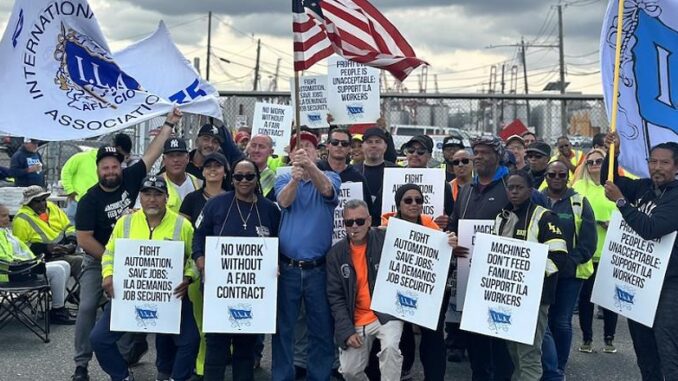
WASHINGTON, DC, October 4, 2024 (ENS) – The International Longshoremen’s Association and the United States Maritime Alliance, Ltd. have reached a tentative agreement on wages and have agreed to extend their current Master Contract until January 15, 2025 to return to the bargaining table to negotiate all other outstanding issues. Effective immediately, all current job actions will cease and all work covered by the Master Contract will resume at East Coast and Gulf Coast ports.
The master contract between union dockworkers and their employers at 14 U.S. East and Gulf Coast ports expired at midnight September 30, as talks came to an impasse over pay and automation. While seeking improved wages and benefits, the central concern of union members is that automation will wipe out their jobs, but they may be too late – automated ports are already a fact of life in the United States.
Early on the morning of October 1, longshoremen walked off the job for the first time in 47 years, closing ports from Texas to Maine. The International Longshoremen’s Association (ILA) is striking against the United States Maritime Alliance, known as USMX, a membership association of employers: container carriers, terminal operators, and port associations.
Initially, the strike by 45,000 dockworkers closed 14 ports: Baltimore, Maryland; Boston, Massachusetts; Charleston, South Carolina; Houston. Texas; Mobile, Alabama; New Orleans, Louisiana; New York/New Jersey; Norfolk, Virginia; Philadelphia, Pennsylvania; Savannah, Georgia; and Wilmington, Delaware, as well as Jacksonville, Miami, and Tampa, Florida.
The ILA-USMX agreement came in the strike’s first week, but if issues are not resolved, the strike could expand to 36 ports that together handle 57 percent of U.S. ocean imports, halting the import of goods from overseas as well as the export of items made in the United States.
The Danish company A.P. Moller-Maersk, one of the world’s largest container shippers, said the U.S. dockworkers strike would affect supply chains, leading to delays in cargo movement, increased costs, and logistical challenges for businesses relying on U.S. East Coast and Gulf Coast ports.
“Longer labor dispute durations may exacerbate disruptions, affecting import and export activities, container availability, and overall operational efficiency,” Maersk wrote in a customer advisory.
Before the current pause was agreed to, Maersk was planning to implement a local port disruption surcharge for all cargo moving to and from the U.S. East Coast and Gulf Coast terminals, ranging from $1,500 to $3,780 a container. Subject to regulatory approval, the charge depends on the impact of the strike on the supply chain.
Leading products to be affected include electronics and automobiles, according to a September analysis by The Conference Board, a nonpartisan think tank based in New York City.
Even a short port strike could cause supply chain interruptions for weeks. The Conference Board predicts that the one-week strike which started October 1 could have caused slowdowns through mid-November.
The economic loss from the shutdown would have been between $3.8 billion to $4.5 billion a day, according to JPMorgan Chase & Co.
Shipping congestion resulting from a week-long strike would take about a month to clear, according to Grace Zwemmer at Oxford Economics, an economics advisory firm based in Oxford, England.
The strike comes just over a month before the U.S. presidential election on November 5, but President Joe Biden, a Democrat and a strong union supporter, says he will not involve himself in this strike.
“Collective bargaining is the best way for workers to get the pay and benefits they deserve. I have urged USMX, which represents a group of foreign-owned carriers, to come to the table and present a fair offer to the workers of the International Longshoremen’s Association that ensures they are paid appropriately in line with their invaluable contributions,” President Biden said.
“Ocean carriers have made record profits since the pandemic and in some cases profits grew in excess of 800 percent compared to their profits prior to the pandemic. Executive compensation has grown in line with those profits and profits have been returned to shareholders at record rates. It’s only fair that workers, who put themselves at risk during the pandemic to keep ports open, see a meaningful increase in their wages as well,” the President said.
Biden has his eye on even larger issues than the strike – the recovery of the nation after deadly Hurricane Helene, which hit the Southeastern states, some of the same states affected by the ILA strike, in the last days of September.
“As our nation climbs out of the aftermath of Hurricane Helene, dockworkers will play an essential role in getting communities the resources they need. Now is not the time for ocean carriers to refuse to negotiate a fair wage for these essential workers while raking in record profits. My Administration will be monitoring for any price gouging activity that benefits foreign ocean carriers, including those on the USMX board,” Biden warned.
The Big Three automakers: Ford, General Motors and Stellantis will also be monitoring the situation closely when negotiations resume, but have not announced independent actions yet.
U.S. Acting Secretary of Labor Julie Su has been closely involved in contract negotiations. “The American economy has defied all expectations thanks to the Biden-Harris Administration’s leadership. There is room for both companies and their workers to prosper,” Su argued. “The parties need to get back to the negotiating table, and that must begin with these giant shipping magnates acknowledging that if they can make record profits, their workers should share in that economic success.”
But for now, container traffic is shut down all along the U.S. Gulf Coast and East Coast ports.
Jack Hollis, head of sales for Toyota Motor North America, said, “I don’t care if it’s one day, two days – every single day of these things can cause issues for people to consider. And yeah, this will affect everybody; it just does.”
Strike Targets Automation, But It’s Already in Progress
While longshoremen worry about losing their jobs to automation and try to negotiate a way around this impasse, automation is already taking over many port functions. Over the past 20 years, container terminals have increasingly incorporated automation, reducing human involvement, according to a March 2024 report by the U.S. Goverment Accountability Office.
Many container terminals now use automated cargo handling equipment and technologies that reduce human involvement in optimizing, tracking, or communicating container movements.
Semi-automated technologies need a human operator located either within a cabin on the equipment or in a remote location to guide containers for the final inches of movement, while fully-automated systems require no human intervention at all.
Automated gate systems use sensors to collect information from trucks and containers, replacing or reducing the number of workers that are manually checking and recording this information. Software is performing tasks traditionally performed by workers.
Automated gantry cranes stack or transport containers to a truck or train, operated by software or by a worker in a remote location, in contrast with conventional equipment that relies on an operator on the crane to move containers.
At the Port of New York & New Jersey, the largest on the U.S. East Coast, terminal operators have invested over $3 billion over the last 20 years on port infrastructure, systems and equipment.
The Port says the automated equipment is “better able to handle projected future volumes and the increasingly larger vessels that carry maritime cargo. Terminal operating partners continue to make additional investments to modernize their facilities, most recently including the purchase of new ship-to-shore cranes, technology upgrades to their gate systems, and sustainability measures to improve energy efficiency.”
ILA Local 24 President Jack Pennington represents longshoremen in Pasadena, Texas, a port within the Houston Metro region with immediate access to the Houston Ship Canal and the Port of Houston. The Port ranks #1 in foreign tonnage and #2 in total tonnage in the United States but is now behind an ILA picket line.
In a September 30 social media post, Pennington had a tough message for the employers, the United States Maritime Alliance, calling automation “the never ending threat that is infiltrating our industry.”
“This is a trend and a reality,” Pennington exclaimed. “So don’t be so quick to judgment on us the longshoremen of this country for fighting for our jobs because who knows when it will be your turn next!! We are fighting for our rights to make a honest living not to allow a robot to wipe us out so that them corporate bastards can buy another vacation island somewhere!!!!”
The ILA says the shippers are now charging $30,000 for a full container, a leap upward from $6,000 per container just a few weeks ago. “In just a short time, they went from 6K, to 18K, then 24K and now $30,000. It’s unheard of and they are doubling their $30,000 fee stuffing the same container from multiple shippers. They are killing the customers,” the union fumed.

“There is a job we have to do right now, and it is the strike, and stay strong and don’t give in,” urged Harold Daggett, International President of the ILA since 2011.
Daggett said the union workers will continue to honor the ILA’s century-long pledge to handle all military cargo, even during a strike. In addition, ILA Longshore workers will continue to work passenger cruise vessels at all ILA ports, so as not to inconvenience the tens of thousands of Americans who have booked trips in advance.
Still, until the current agreement, reached the evening of October 3, the union was sticking to its strike plan.
“We are now demanding $5 an hour increase in wages for each of the six years of a new ILA-USMX Master Contract,” said President Daggett. “Plus, we want absolute airtight language that there will be no automation or semi-automation, and we are demanding all Container Royalty monies go to the ILA.”
Some of these issues are still to be resolved, but the wage agreement has been reached – $4 an hour increase for each of the six years covered by the new Master Contract.
But this week, as the strike began, the struggle turned ugly. Daggett and other top ILA leaders are the targets of hate and threats of violence. The “New York Post” newspaper this week published aerial photographs of Daggett’s New Jersey home, and his address.
“The publication of pictures of Mr. Daggett’s home is reckless and places Mr. Daggett and his family at great risk of personal harm,” his attorney, Michael Critchley, wrote to Genie Gavenchak, the senior vice president and deputy general counsel for the Post’s parent company News Corp. Asking that the newspaper remove the pictures of Daggett’s home immediately, Critchley wrote, “Mr. Daggett has already received several threats to his life.”
Featured image: Striking members of the International Longshoremen’s Association picket at the port in Elizabeth, New Jersey. October 2, 2024 (Photo courtesy Labor Notes)
© 2024, Environment News Service. All rights reserved. Content may be quoted only with proper attribution and a direct link to the original article. Full reproduction is prohibited.



